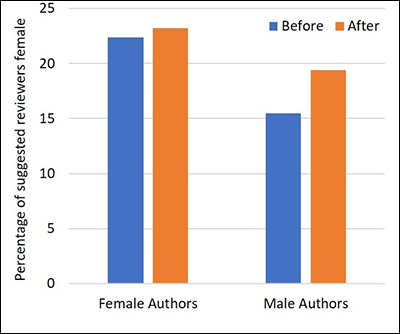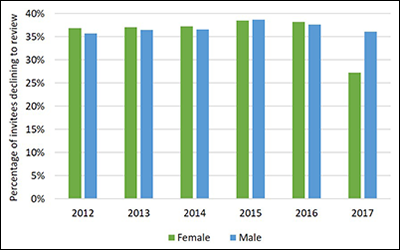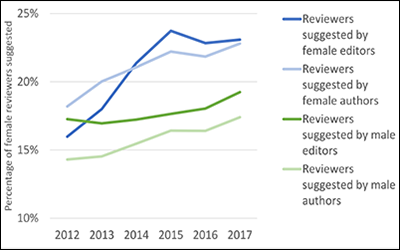Since the publication this past January of a study showing underrepresentaton of women as reviewers of papers submitted to journals of the American Geophysical Union (AGU), the organization has taken multiple steps to address issues of diversity and bias in peer review. AGU has been striving to deepen its understanding of disparities in its review process related to such factors as gender, age, and geographical location and to explore ways to counteract those biases.
The conclusions of the study, conducted by the authors of this article and published in Nature, were that women were being used less as reviewers in nearly all age groups compared to expectations based on their higher success rates as authors and their distribution with age in the AGU membership. This bias initiated from author suggestions and persisted through invitations from editors. It was exacerbated by a higher decline rate among women in the younger age cohorts.
The editors in chief have worked to expand diversity on their teams (both editors and associate editors) and to discuss the larger bias among peer reviewers.
Along with those findings of gender bias in peer review, overall data clearly show that AGU needs to engage more younger scientists in reviewing and also more scientists from Asia and Africa. AGU recruits a large proportion of its reviewers from the United States, Canada, and Europe, whereas accepted authors reside roughly equally in North America, Europe, and Asia.
Action and Results
Since we began to analyze the data for the Nature study, we have been discussing these issues with AGU journal editors and their editorial boards. In turn, the society’s editors in chief have worked to expand diversity on their teams (both editors and associate editors) and to discuss the larger bias among peer reviewers.
This past spring, we also conducted an experiment in explicitly encouraging authors to recommend diverse reviewers. On 1 April 2017, with the support of the editors of our largest journal, Geophysical Research Letters (GRL), we added a note to the GRL submission form that asked authors to help the journal improve the diversity of its reviewer pool by including women, young scientists, and members of other underrepresented groups in their lists of suggested reviewers.
We have now analyzed the results from that experiment and found that with regard to gender diversity, this simple step had a salutary effect.

Figure 1, which shows a comparison of the percentage of female reviewers suggested by authors in the 3 months before and after this note was included, reveals that gender diversity increased significantly. A comparison with data across all other AGU journals rules out other factors in producing this change, such as awareness of our study published in January 2017.
Given the success of the recent test, we will now be including the statement, which is quoted in its entirety below, across all our journals, not only in the instructions for authors but also as a reminder to the editors when they select reviewers.
The statement will read as follows (as it did on the GRL site):
Evaluation of our journals’ peer review practices suggests that women were less likely than men to be asked to review. Please help us improve the diversity of our reviewer pool by including women, young scientists, and members of other underrepresented groups in your suggested reviewers (e.g., age, ethnic, and international diversity).

Other data show a marked increase in the acceptance of the invitation to review, especially by women, in 2017 to date, as shown in Figure 2. This increase likely reflects a broader awareness of this issue prompted by our Nature paper, as well as our conference presentations about that study and other coverage of its findings. In that study, we merged information on age and gender from AGU membership data with editorial data on authors and reviewers. This provided a large sample of activities and allowed accounting for age in exploring gender bias.
More Work to Do

As shown in Figure 3, AGU journals continue overall to expand the gender diversity of our reviewer pool.
Although the gender diversity of reviewers has improved, the data for 2017 indicate that the GRL reminder statement has not so far led to a significant change in recruiting reviewers for that journal who are younger or from countries outside North America and western Europe. Thus, there is more work to do.
To help, AGU editors have been conducting workshops on reviewing internationally, including recently at the International Geological Congress meeting in Cape Town, South Africa, and the Japan Geoscience Union–AGU meeting in Chiba, outside of Tokyo, and in visits to universities and research institutions in China. AGU Publications has also conducted several webinars on reviewing, including the most recent on “How to Write Effective Reviews (and Improve Your Own Manuscript),” and will expand these efforts further.
AGU will continue to collect and report data on reviewer diversity in its scientific publishing and provide regular updates. We hope that these results encourage other journals and publishers to take more direct efforts to expand and diversify the reviewer pool.
—Brooks Hanson (email: [email protected]), Senior Vice President, Publications, AGU; and Jory Lerback, Data Analyst, Publications, AGU; now at Department of Geology and Geophysics, University of Utah, Salt Lake City
Citation:
Hanson, B.,Lerback, J. (2017), Diversifying the reviewer pool, Eos, 98, https://doi.org/10.1029/2017EO083837. Published on 04 October 2017.
Text © 2017. The authors. CC BY-NC-ND 3.0
Except where otherwise noted, images are subject to copyright. Any reuse without express permission from the copyright owner is prohibited.

